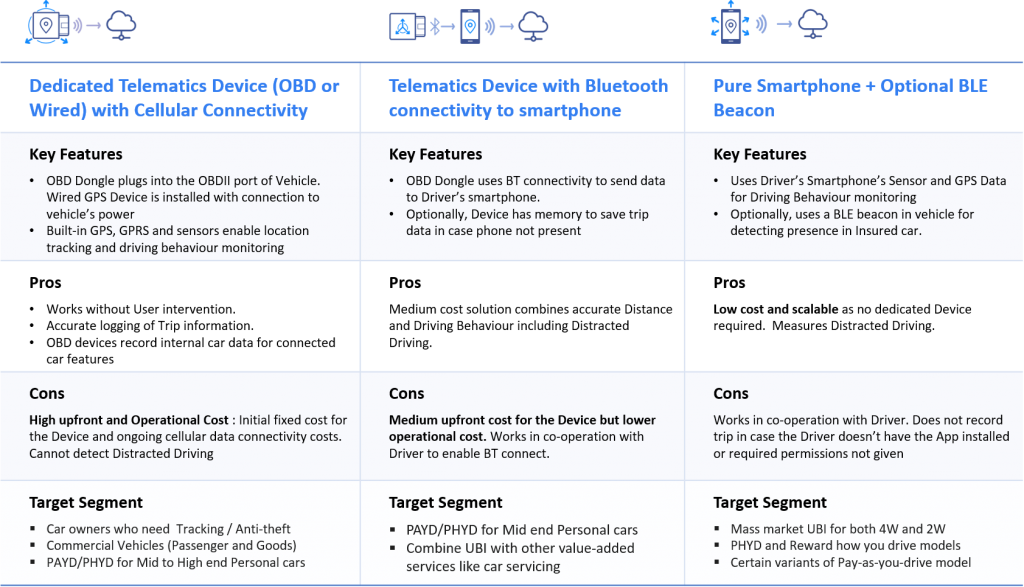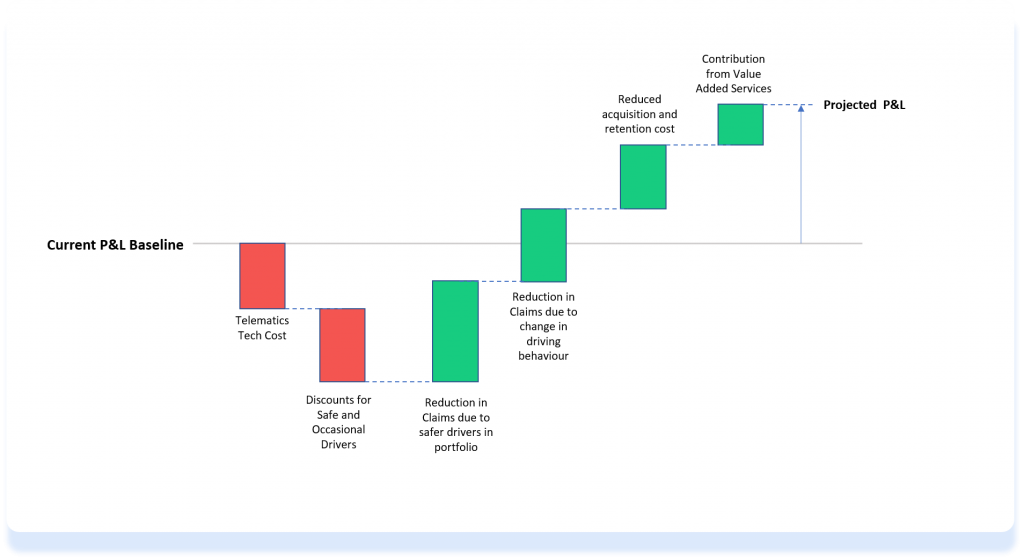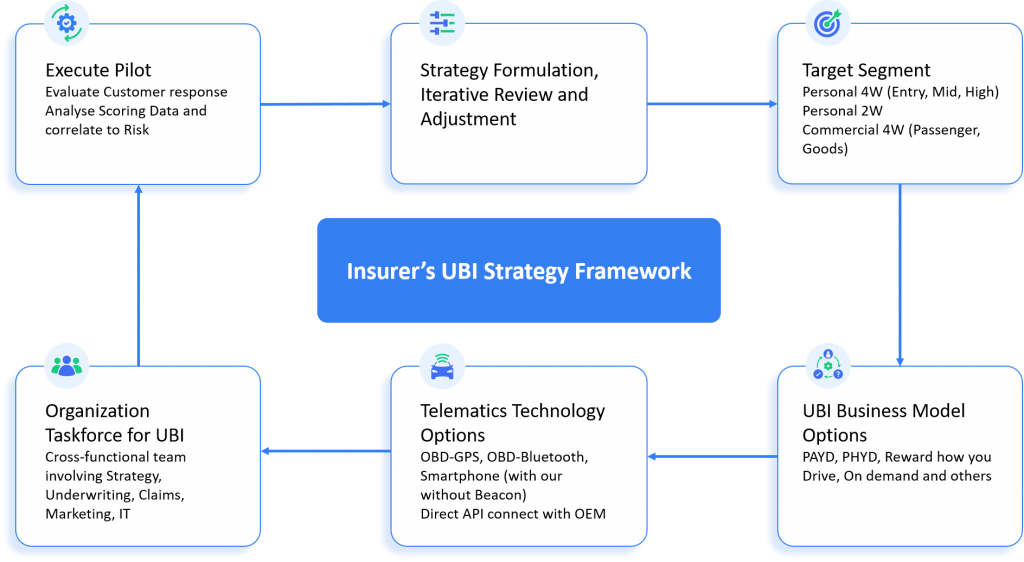Recent regulation in India permits Usage Based Insurance
Implications and strategic choices for Auto Insurers and other industry participants

What’s changed
On July 5, 2022, IRDAI (Insurance Regulatory and Development Authority of India) notified that Insurance companies could offer Usage Based Insurance (UBI) as add-ons to their Own Damage policies. These include Pay As You Drive, Pay How You Drive and Floater policy. As the circular indicates, the aim is to keep pace with new technology related developments in the market and to increase the penetration of Own Damage Insurance in India.
The announcement allows Insurers the flexibility to offer UBI as mainstream products. Before this, Insurers have conducted limited experiments under the Sandbox schemes. Insurers could offer these products for a limited period and with an upper cap on the premia. The UBI announcement, combined with other recent moves allowing ‘use and file’ procedures and aggressive growth goals suggested by the Regulator, has created a certain buzz in the Motor Insurance industry.
Some Analysts and Insurance protagonists have called this regulatory change as revolutionary and game changing for the Motor Insurance industry. On the other side, there are commentators and players who have downplayed the significance of Usage Based Insurance in a market like India.
In either case, the move has forced the industry participants to take notice and develop their own strategy about Usage Based Insurance.
This article discussed the strategic choices and implications for Insurers with the changed scenario allowing Usage Based Insurance in India. This article articulates our views based on interactions with various Insurance players over the years, as well as our understanding of Indian vehicle owner preferences based on our experience selling Connected Car and Telematics solutions.
Motor Insurance Business Scenario
Before we analyze the likely impact of Usage Based Insurance, here are a few key points regarding the status of the Motor Insurance industry:
- Motor insurance market growth is muted with GDPI (Gross Direct Premium Income) underwritten growing by around 4% to INR 70,000 Cr in FY2022. The growth reflects the underlying growth issues with the Automotive industry. Own damage forms roughly 38% of this total.
- There is a high degree of competition with 21 private players along with 4 public general insurance players
- Net Incurred Claims in Motor OD have hovered above 80% and the overall combined ratio of General Insurers remains close to 120%.
In our talks, most industry participants agreed that the most important criteria that customers consider while choosing a Motor Insurance policy is price. And combined with the high intensity of competition, this implies that the Insurance premiums are already too low in Indian market.
Business Case for UBI
Given the above scenario, we try to create a Business Case for Usage Based Insurance while understanding the impact it’s likely to have on topline and bottom line for Insurers.
Cost Side of equation
Usage Based Insurance, such as Pay as you drive and Pay how you drive, requires the use of Telematics for Insurers to measure the driving behavior of the Insured. This adds an additional cost component, whose magnitude depends on the telematics technology adopted. And given that each technology option has its own pros and cons vis-à-vis the UBI business model, and associated costs, deciding the Technology option has a significant impact on the Business Case formulation.
Figure 1 compares the key Telematics technology options and their pros and cons.

Figure 1 : Comparing Telematics Technology Options for Usage Based Insurance
Apart from the Technology cost, UBI business model inherently involves offering discounts to Users based on Driving behavior. This can be based on the distance or usage of the vehicle in case of PAYD or also takes into account the Safe Driving behavior of Driver in case of PHYD.
Theoretically, UBI should mean lower premiums than the base for Safer and occasional drivers and higher premiums than the base for Rash and frequent drivers. However, given the current state of the market, UBI in India at the initial stage would only mean lower premiums (discounts) for Safer and occasional drivers.
Profit side of Equation
Reduced Underwriting Losses
The main benefit for UBI for Insurers is that by incentivizing the Safe and occasional driving, the underwriting losses come down. Here, there are multiple factors at play which makes this possible:
- As a nature of the product itself, UBI is attractive to drivers who are safer and drive less. This means an Insurer who offers discounts against these rating variables automatically self-selects a pool of customers who are less risky.
- By quantifying the driving behavior for each user and encouraging them to earn more discounts by driving safely, PHYD has a behavior modification aspect that lowers the risk profile of the insured pool progressively.
One counterpoint related to the above is the lack of statistical evidence in the Indian market that occasional or safe driving behavior will lead to lower claims.
Given that UBI is new and not enough critical mass of experiments have been done so far, this is a typical chicken and egg issue. Insurers should look at the global examples of positive impact of UBI in controlling losses, including markets similar to India which had high loss ratios and frauds prior to the start of Insurance Telematics.
Also, Insurers can look at the surrogate data related to accidents recorded in India including their distribution based on location (city vs rural, highway vs non-highway), time of day (night vs day). We analyzed our telematics data from a pool of Indian car owners to see the variability in the Usage and Driving behavior. There is a wide variation in the weekly distance covered and the Safe driving scores.
These indicate that rating factors that take such usage and driving behavior variables into account are likely to have different claim profiles than the base case.
So, while solid actuarial evidence will take a few years to emerge, in the interim Insurers need to use rational approach to devise UBI products and price them.
Attracting and retaining customers
In a market where all Insurance products look similar and customers pick purely on price, UBI offers an advantage for early movers to offer a differentiated product and rise above the clutter with a fresh offering. Also, customers who do get discounts based on their driving behavior are more likely to stay with the same policy, thus increasing customer retention.
Also, Telematics Insurance offers the benefit of higher customer engagement, which is quite powerful, though might seem intangible. With Telematics Insurance, customers move from a transactional relationship to a value-adding relationship. Currently, Insurers have limited touch-points of Policy renewal (once a year) or a Claim (once in several years). With Telematics Insurance, the touch points increase to once a week or more with the help of customized insights and rewards for the car owner in the Insurer’s App.
Thus, UBI can pave the way for more direct and online sales and reduced commissions paid out to Agents and Brokers.
Telematics also enables Insurers to offer additional services such as Emergency Response and Road-side assistance triggered via Automatic Crash Detection. With black box telematics, Insurers can offer stolen vehicle recovery and car finding features. Evidence from telematics data at the time of accident can help customers get quicker and hassle-free claim resolution experience. Car usage and condition information can be used to drive allied vehicle Servicing and Repair offers and reminders.
Figure 2 summarizes how cost and profits stack for the UBI Business Case

Strategic Options for Insurers and Intermediaries
With the IRDAI announcement, we sense that Insurers are evaluating their strategic stance related to Usage Based Insurance. Broadly, the strategic response can be in one of the following three buckets:
- Wait and Watch – Learn from outcomes of the other early adopters
- Test market – Undertake pilots on limited scale to understand customer acceptance and impact on bottom line
- Dive-in whole heartedly – Position as an early mover and adopt a leading position in the UBI space
Our view is that several of the leading and established private players shall start with a Test market approach and offer an add-on UBI product to test customer acceptance and gather data. Several of these Insurers have already adopted digital insurance innovations and have a large client base using their Insurance Apps. It will be easier for these players to include Smartphone Telematics option in their App and directly target a digital savvy segment of their user base with Telematics Insurance.
At the other end of the market share table, some of the players with low market share could dive in whole heartedly and aggressively adopt Usage Based Insurance as an opportunity to position themselves as innovators and gain share of safe drivers while gradually ignoring unsafe drivers.
For some of the players in the middle with no strong digital presence, UBI presents a dilemma. They could use UBI as an opportunity to anchor and overhaul their digital Insurance offerings. Others may well go for a wait and watch approach and learn from the experiences of others.
In terms of the UBI Business Model, PAYD is simple to understand and would likely be the first choice for most insurers to implement. However, we believe that for a low premium market like India with a high rate of accidents, PHYD may be a better model in the long run. PHYD (including elements of Driving behavior and distance/location) is likely to be a better predictor of risk, has a behavior change benefit and would enable faster reduction in claims.
In terms of Telematics Technology option, we expect some of the players to adopt a portfolio approach. Smartphone Telematics is likely to be the most preferred for personal lines owing to the low cost and scalability. However, for pay per mile type of products, Insurers may go for Device based solutions targeted at specific segments where the additional cost of technology can be balanced against the benefits.
For Commercial lines of business (passenger and goods carrying vehicles), a Dedicated Telematics Device with Cellular connectivity (Wired or OBD Dongle) is the most suited option.
Insurers would also do tie-ups directly with OEMs to access telematics data directly from the OEM fitted Connected cars. However, we expect this to be still limited given the inherently fragmented nature of this approach and the OEM fitted connected cars representing a miniscule portion of the current installed base of vehicles.
Ideally, Insurers should partner with Telematics Solution providers that provide multiple telematics technology options with a unified Telematics platform enabling Insurers to seamlessly mix and match options for different segments.
Usage Based Insurance impacts multiple Insurance functions including Acquisition, Underwriting, Marketing, Claims, Digital, Strategy and IT. This means that a UBI initiative needs to bring together multiple stakeholders within the Insurance organization to a common vision and provide necessary impetus to make it happen. In such a scenario, Insurers where the top management has a “buy-in” on the UBI initiative are more likely to drive adoption faster and not get bogged down in internal committee-based discussion making.
Figure 3 outlines a strategic decision-making framework for Insurers to plan for UBI

For Insurance Intermediaries such as online brokers, UBI presents an opportunity to increase touchpoints with their targeted customer base and drive lead conversion.
New age Digital Insurance brokers, such as Payment and other “Super Apps”, already have digital engagement with hundreds of millions of vehicle owners. They are likely to offer Smartphone based Connected Insurance solutions underwritten by their partner Insurers. Another interesting use case for such intermediaries is to incentivize their customers to share driving behavior for a month or so before renewal and use that score to offer additional discounts for safer drivers. As Super Apps, they are better positioned to use the Telematics data to cross-sell other services in partnership with ecosystem players such as Parking/toll payments and discounts, car servicing and repair and fuel saving tips / loyalty points.
Companies employing gig-economy workers such as ride hailing, food delivery and ecommerce/grocery delivery are increasingly going to be held responsible for the safety of their drivers/riders and covering for their accident Insurance. Connected Insurance Technologies can help them promote safe driving/riding practices and bargain for lower Insurance premiums based on their aggregated risk profile.
What’s in it for the Customer
Finally, we analyze the question of what’s in it for the Customer to take a Usage Based Insurance product.
In our view, this will depend upon the interplay of benefits for the customer vis-à-vis the notional “cost” of sharing data with the Insurer. Benefits include the tangible premium discount benefit and other intangibles including additional services and engagement enabled via Telematics. Customers are increasingly used to paying for various services based on Usage and hence would find a natural mental fit with the concept of Usage based insurance.
Trust is absolutely the key in that the Customer needs to be convinced that data shall not be misused to specifically deny a claim.
Generally, a program that rewards safe drivers while coaching rash drivers is likely to have higher end user acceptance as compared to a program with a zero-sum approach of reducing premium of safe drivers at expense of unsafe drivers. Based on some of the global examples, we consider Reward as you drive type programs that reward safe drivers based on good driving behavior could be the right template for the Indian market.
Messaging around the product needs to be positive where it’s about making driving safer, fun and rewarding and not about penalizing bad drivers.
Also, behavioral economics tells us that customers are likely to adopt products that offer rewards and discounts in near term and frequently. So, a UBI product that offers savings on a weekly or monthly basis is more attractive compared to a UBI product that offers a discount at the end of one year at the time of renewal.
Crystal ball gazing
Overall, we are optimistic about the prospects of the Usage Based Insurance in India. We predict that more than half of the private Insurers will offer UBI products in some form or other in the next twelve months. A few early announcements by large players could trigger a FOMO response from other players.
With multiple experiments by Insurers under different UBI business models and technology options, we foresee a steep learning curve for the industry to figure which models and technologies works best for which segment.
Post this phase of experimentation and data gathering, we expect UBI to truly become a viable mainstream product in India. It’s conceivable that the share of UBI policies might reach 20% of all 4W OD policies in the next 3-4 years.
Author:

Kamal Aggarwal
Co-founder and CEO
SenSight Technologies Private Limited
Kamal Aggarwal is Co-founder and CEO of SenSight Technologies, a startup working at the intersection of Automotive IoT and Big Data. SenSight’s AutoWiz Connected Vehicle Data Analytics Platform powers use cases for players in the Automotive, Insurance and Shared Mobility domain. Kamal has 20+ years of experience in Strategy, Marketing and Product Management for high tech ventures.
Published in Telematics Wire





